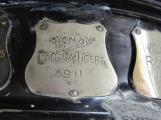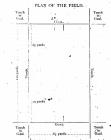1
The Canadian Rugby Football Union (CRFU), predecessor of the Canadian Rugby Union (CRU) was formed in February 1884. The rules that the CRFU gathered was from the Ontario Rugby Football Union (ORFU), known as the Burnside Rules. The purpose of the CRFU was to establish a Canadian Championship. With that idea in mind, the CRFU established the Dominion Cup. In the first ever Dominion Cup, the match was between ORFU champions Toronto Argonauts, and Quebec Rugby Football Union (QRFU) champion Montreal, in which Montreal won 30-0. During the 1885 season, the CRFU decided that playing fields from the ORFU and the QRFU have to be 100 yards in length, and 65 yards wide (these are the same dimensions that are part of the CFL today). In the same year, there was no championship due to a disagreement of rules between the QRFU and the ORFU, so the CRFU decided to play an all-star game between these two unions which ended in a draw. Another rule change that the CRFU established was in 1886 was that a quarterback can now run or kick the ball only after the defensive team had crossed the line of scrimmage, but like before the ORFU did not like the rule change, thus eliminating the Dominion Cup for that season. In 1887 frustrated with the CRFU, the ORFU withdrew and from that action the CRFU ceased to exist. With no CRFU anymore, the ORFU decided that the Dominion Cup can still be played and a match was set up. Ottawa College from the ORFU defeated Montreal, and won the Dominion Cup that season. After the QRFU and ORFU finished the 1891 season, there was a meeting between the two unions. During that meeting the Canadian Rugby Union (CRU) was formed. In the Dominion Cup game in 1892, Osgoode Hall of the ORFU defeated Montreal ad won the Dominion Cup. In 1896, the CRU decided that that the previous game length was long, so the CRU decided to reduce it to two 40-minute halves. Also the size of the field was now set to 110 yards by 65 yards. In that same season, the CRU produced the "Constitution, Rules of the Championship Competitions and Rules of the Game". This was the first official rule book.3
In 1897, once again the CRU decided to change the length of the matches, now it was two 35-minute halves.The next year in 1898, the CRU accepted the Canadian Intercollegiate Rugby Football Union (CIRFU) in which the CIRFU withdrew months later. Also during the same year, the CRU decided to change the length of the game again, this time the game consisted of 30-minute halves.
4
At the beginning of the new century, the CRU decided on a new rule to help the players. The new rule is now that players must block with their bodies, and holding the player is not acceptable. In 1901, the CRU employed another new rule. This new rule states now that the ball is going to be placed on the ground before the lines can come together (In today's term, it is a hike). 1903 was a significant year for all of Canadian football. This was the year that the Burnside Rules came into effect. With the Burnside Rules, the CRU was not interested with those rules and decided to continue to make new rules as seasons go by. Also in the same year, the CRU decided that it is time to reduce the players from the field from 15 to 14 and implement the three scrimmages rule. The scrimmage rule states that possession cannot go beyond the third scrimmage, unless during the third scrimmage the ball was moved forward five yards by a kick or a run. During the 1905 season, the CRU now decided that all Dominion Cup games the QRFU rules will be used during the first half of the game, and the Intercollegiate Canadian Rugby Football Union (ICRFU) rules in the second half. During the 1907 season, significant strides were now in place for Canadian Football today in which the CRU adopted the ICRFU rule that there has to be a one yard between opposing lines, and play cannot start until the ball was in play. Clubs now have to gain 10 yards in three or fewer scrimmages, or forfeit possession of the ball. The ORU like these rules, that they adopted them. The next season in 1908, the CRU decided that goals from the field are now worth three points instead of four. During the 1909 season the Grey Cup was first played for and the CRU decided that only unions registered can play for the Grey Cup.5
In 1911, the Alberta, Manitoba, and Saskatchewan Unions talked and decided to form one union. The Western Canada Rugby Football Union was born and Hugo Ross decided to donate a trophy for the champions of Western Canada. Calgary won the first every Hugo Ross trophy, but was denied to play for the Grey Cup, because the CRU said that Calgary was not a member of the CRU.6
A shield commerating Calgary Bronks winning in 1911. This shield can be found on the Hardy Cup.Circa 1911

